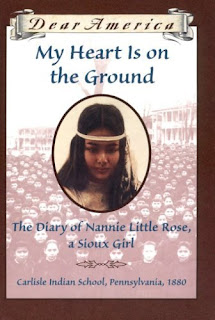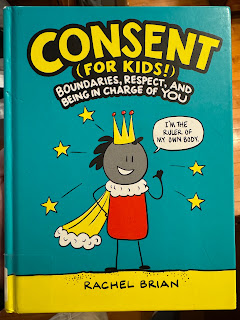Historical fiction has never been my preferred genre. I generally find the concept of creating fictional stories around real events to be in poor taste. However, I admit that while this can be the case, it is not always. Historical fiction differs from contemporary realistic fiction by setting the events of the story in a real time period in the past, centered around the experiences of people who were around during that time. Many stories can be presented in a way that is respectful to the lived experiences of those from our past, but this requires a deft hand at writing and loads of research to make sure information is not being presented that is inaccurate. Many children end up reading historical fiction and learning about history through it. As such, it is important that the majority of the information being presented by the author is done in a way that is respectful and accurate.

Rinaldi, Ann. My Heart is On the Ground: The Diary of Nannie Little Rose, a Sioux Girl. Scholastic, Inc. 206 pages. ISBN 978-0590149228
This is an example of that first type of historical fiction: one that is based off of real people and real events, but told in such a way that is completely off base with reality to the point that it is insulting to read to anyone who has any knowledge of the true experiences of Native Americans who were put into boarding schools in the 1800s. Rinaldi's work is full of stereotypes, and presents these boarding schools as places where children wanted to be, presenting the experiences these real children had as being positive and beneficial, when they were anything but. Throughout reading this book, I had to pause multiple times to reflect on exactly how against fact many scenes and interactions were. This is a perfect example of white savior garbage, and does a tremendous disservice to the real historical events. I would never suggest this book for anyone except for as an example of everything NOT to do in a historical fiction novel.

Lai, Thanhhá. Inside Out and Back Again. HarperCollins. 272 pages. $16.99, ISBN 978-006192783
A different case from the above, this novel written in verse tells the story of Há Kim and her family's escape from Vietnam during the war after her father goes missing. Há discusses her experiences moving on without her father, through Guam and eventually through to Alabama. Lai based the story of Há and her family after her own experiences as a refugee. This first-hand knowledge by Lai is very important, as the fictional accounts being written follow realistic events. Unlike Rinaldi, Lai shows a tremendous amount of respect for the source material. The writing is done in a way that presents the story as something that truly could have happened, because research and writing was done with respect.
McManis, Charlene Willing. Indian No More. Tu Books. 211 pages. $18.95, ISBN 978-1620148396
An interesting counterpoint to My Heart is On the Ground. In this book, McManis does a much better job of presenting a story about a Native American experience in the United States. Taking place during the Civil Rights era, it is the story of a girl who must come to understand why her existence is seen as a negative to White America. McManis writes with a respect for the lived experiences of the peoples discussed in the writing, and does so without ignoring the real challenges that people faced during this time period and in many ways still continue to face. While it is a fictional story, it does not feel like make believe. Indian No More is everything that My Heart is On the Ground wasn't.






Comments
Post a Comment